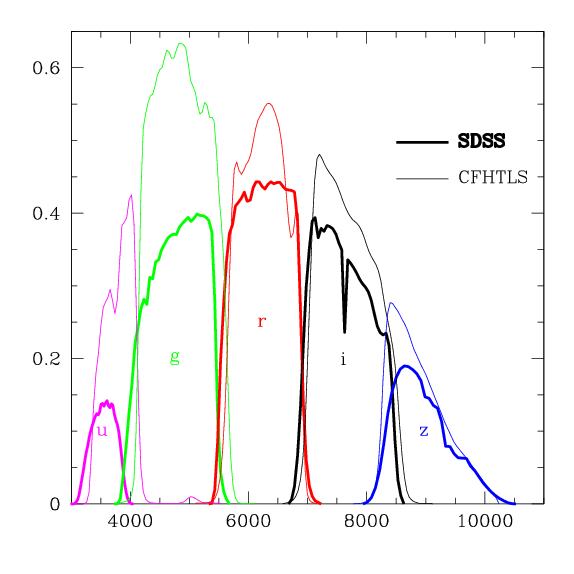
Caption: A graph showing a comparison of the passbands (AKA transmission functions, AKA response curves) of the SDSS ugriz filters of the Sloan Digital Sky Survey (SDSS) and CFHTLS ugriz filters of the Canada-France-Hawaii Telescope Legacy Survey (CFHTLS).
Features:
- Here we are only interested in the
SDSS ugriz filters which
are the thick curves
on the graph.
- The horizontal axis is wavelength
in angstroms (Å): 1 m = 10**6 μm = 10**10 Å
and 1 μm = 10**4 Å.
- The vertical axis is transmission probably a fraction of perfect transmission (i.e.,
1).
- The SDSS ugriz filter transmission functions
include the effects of whole optical system of the
SDSS 2.5-m telescope
and extinction through an air mass of 1.3 at
Apache Point Observatory
where SDSS has
the SDSS 2.5-m telescope
(see SDSS: Camera).
Apache Point Observatory is located in Sacramento Mountains in Sunspot, New Mexico at altitude 2788 m.
- The air mass at
sea level toward
zenith is defined to be
1.
There are various ways of calculating
(see Wikipedia: Air mass:
Calculating air mass) and quantitatively determining what it means
(see Wikipedia: Air mass:
Air mass and astronomy).
However, the bottom line is the more air mass,
the less flux from an
astronomical object and the more
distortion of the astronomical object.
The 1.3 air mass for the SDSS ugriz filters probably is a characteristic value for Apache Point Observatory and probably accounts for most of the reduction of the peak transmission of the the filters below a perfect 1. But we'd need an expert to explain it all accurately.
- SDSS ugriz filters are characterized as follows